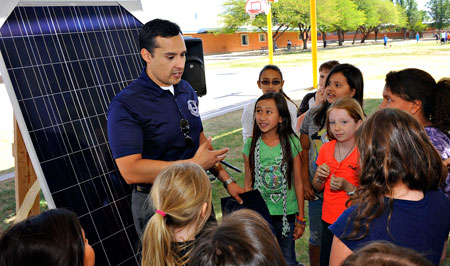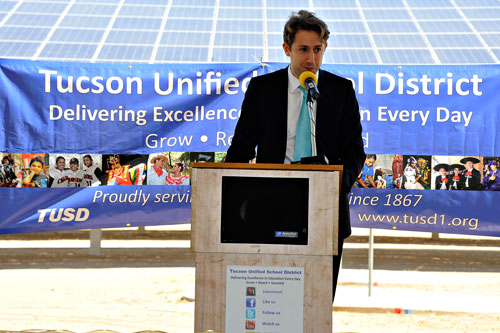Phased construction for the first group of schools began during the first quarter of 2014.
Solar Project Sites
- Erickson Elementary School, 6750 E Stella Rd. - Site Plan (in PDF)
- Gale Elementary School, 678 S Gollob Rd. - Site Plan (in PDF)
- Henry Elementary School, 650 N Igo Way - Site Plan (in PDF)
- Marshall Elementary School, 9066 E 29th St. - Site Plan (in PDF)
- Secrist Middle School, 3400 S Houghton - Site Plan (in PDF)
- Soleng Tom Elementary School, 10520 E Camino Quince - Site Plan (in PDF)
- Wheeler Elementary School, 1818 S Avenida del Sol - Site Plan (in PDF)
- Bonillas Basic Curriculum Magnet School, 4757 E Winsett Blvd - Site Plan (in PDF)
- Howell Elementary School, 401 N Irving Ave - Site Plan (in PDF)
- Kellond Elementary School, 6606 E Lehigh Dr - Site Plan (in PDF)
- Lineweaver Elementary School, 461 S Bryant Ave - Site Plan (in PDF)
- Mary Meredith K-12 and Duffy Family Center, 755 N Magnolia Ave - Site Plan (in PDF)
- Myers-Ganoung Elementary School, 5000 E Andrew St - Site Plan (in PDF)
- Sewell Elementary School, 425 N Sahuara Ave - Site Plan (in PDF)
- Carrillo K-5 Magnet School, 440 S Main Ave. - Site Plan (in PDF)
- Cavett Elementary School, 2120 E Naco Vista - Site Plan (in PDF)
- Drachman K-6 Montessori Magnet School, 1085 S 10th Ave. - Site Plan (in PDF)
- Hollinger K-8 School, 150 W Ajo Way - Site plan available soon
- Lee Instructional Resource Center, 606 S. Plumer - Site Plan (in PDF)
- Ochoa Community Magnet School, 101 W 25th St. - Site Plan (in PDF)
- Robison Magnet Elementary School, 2745 E 18th St. - Site Plan (in PDF)
- Grijalva Elementary School, 1795 W Drexel Rd - Site Plan (in PDF)
- Maldonado Elementary School, 3535 W Messala Way - Site Plan (in PDF)
- Mary Belle McCorkle Academy of Excellence K-8, 4455 S. Mission Rd - Site Plan (in PDF)
- Miller Elementary School, 6951 S Camino de la Tierra - Site Plan (in PDF)
- Oyama Elementary School, 2700 S La Cholla Blvd - Site Plan (in PDF)
- Van Buskirk Elementary School, 725 E Fair St. - Site Plan (in PDF)
- Warren Elementary School, 3505 W Milton Rd - Site Plan (in PDF)
- White Elementary School, 2315 W Canada St - Site Plan (in PDF)
- Blenman Elementary School, 1695 N Country Club Rd. - Site Plan (in PDF)
- Collier Elementary School, 3900 N Bear Canyon Rd. - Site Plan (in PDF)
- Cragin Performing Arts Magnet Elementary School, 2945 N Tucson Blvd. - Site Plan (in PDF)
- Davidson Elementary School, 3950 E Paradise Falls Dr. - Site Plan (in PDF)
- Fruchthendler Elementary School, 7470 E Cloud Rd. - Site Plan (in PDF)
- Manzo Elementary School, 855 N Melrose Ave. - Site Plan (in PDF)
- Miles Exploratory Learning Center School, 6951 S Camino de la Tierra - Site plan available soon
- Pueblo Gardens K-8 School, 2210 E 33rd St. - Site Plan (in PDF)
- Robins K-8 School, 3939 N Magnetite Ln. - Site Plan (in PDF)
- Tolson Elementary School, 1000 S Greasewood Rd. - Site Plan (in PDF)
- Tully Elementary Magnet School, 1701 W El Rio Dr. - Site Plan (in PDF)
- Whitmore Elementary School, 5330 E Glenn St. - Site Plan (in PDF)
Ground broken on first solar-power installation
Posted February 19, 2014Solar power is on its way to Marshall Elementary School.
Work has started on the first of more than 40 solar-power systems that will be installed at Tucson Unified School District schools.
The solar program represents the district's commitment to using renewable energy and reducing its carbon footprint while saving money. More than 19,000 tons of carbon dioxide emissions will be averted from local power plants in the project's first full year of operation, along with 23.5 tons of nitrous oxides.
The 18-month project is expected to save TUSD approximately $170,000 in the first year and more than $11 million in energy costs over 20 years. As an added benefit, the majority of the 38,000 solar panels will be placed over playgrounds to provide shading.
Bringing solar to schools provides students with an up-close view of alternative energy at work. TUSD expects to incorporate an educational component, with the goal of encouraging students to pursue careers in science, technology, engineering and math – or STEM.
The other schools in the first group to be "solarized" are Erickson, Gale, Henry, Soleng Tom and Wheeler elementary schools, as well as Secrist Middle School. Construction at each school is expected to last about 10 weeks.
TUSD celebrates completion of first of 40 solar structures
Posted May 9, 2014
Tucson Unified School District will celebrate the completion of the first solar structure installation in its 40-school solar project on May 13 at Marshall Elementary School.
The ribbon-cutting ceremony will feature speakers Superintendent H.T. Sanchez, Tucson Mayor Jonathan Rothschild, Wendy Erika Werden, who is an outreach coordinator for U.S. Rep. Ron Barber, and Rob Dallal, director of Natural Power & Energy, the district's partner in the project.
The installation will be decorated with suns made by Marshall Elementary School first-graders, and the OMA Recorder band, made up of about 60 third-graders and their teachers, will perform a song called, "Let Me Be a Light."
Tina Cook, the TUSD's energy projects manager, said the benefits of the district's solar project, which is the largest of its kind locally, are wide-reaching.
"Solar energy has a reduced dependence on fossil fuel, a limited impact on environment, and reduces the demand on an electricity transmission grid," Cook said.
Over 19,000 tons of carbon dioxide emissions will be averted from local power plants in the project's first full year of operation, along with 23.5 tons of nitrous oxides.
The solar structures, which will be strategically placed to provide shade on playgrounds when possible, will also reduce the district's energy costs.
"Schools are large consumers of energy and, with TUSD's current electricity budget of $13 million, solar is not only a good long-term investment, it also frees up school resources to be spent in the classroom," Cook said.
In the first year after the panels are installed, TUSD expects to save about $170,000 in energy costs. Over the 20-year life of the project, the district expects to save $11 million.
In addition to environmental and financial benefits, the solar panels will generate learning opportunities. Students can experience the practical benefits of solar in action through project-based learning opportunities, Cook said.
At Marshall Elementary, engineers from Raytheon will be coming in to work with students, and the panels will be incorporated into classroom activities.
"Having the solar panels on our campus helps teachers expand lessons in science," said Christopher Loya, principal at Marshall.
The district competitively selected Natural Power and Energy, one of Arizona's leading solar companies, to oversee construction and financing based on the company's experience in working on large solar projects, and the project's ability to save the district money. TUSD had no up-front investment and will purchase energy from the solar systems at a fixed rate over 20 years.
The solar project has been implemented in phases.
Phase one: Marshall, Erickson, Gale, Henry, Marshall, Soleng Tom and Wheeler elementary schools, as well as Secrist Middle School.
Phase two: Bonillas Basic Curriculum Magnet, Howell, Kellond, Lineweaver, Myers/Ganoung and Sewell elementary schools and Mary Meredith K-12.
Phase three: Drachman K-6 Montessori School, Carrillo K-5 Magnet, Cavett Elementary, Hollinger K-8, Lee Instructional Resource Center, Miles Exploratory Learning Center, Ochoa Community Magnet and Robison Magnet Elementary.
Phase four: Grijalva Elementary School, Maldonado Elementary School, Mary Belle McCorkle Academy of Excellence K-8, Miller Elementary School, Oyama Elementary School, Van Buskirk Elementary School, Warren Elementary School and White Elementary School.
Posted May 9, 2014
Tucson Unified School District will celebrate the completion of the first solar structure installation in its 40-school solar project on May 13 at Marshall Elementary School.
The ribbon-cutting ceremony will feature speakers Superintendent H.T. Sanchez, Tucson Mayor Jonathan Rothschild, Wendy Erika Werden, who is an outreach coordinator for U.S. Rep. Ron Barber, and Rob Dallal, director of Natural Power & Energy, the district's partner in the project.
The installation will be decorated with suns made by Marshall Elementary School first-graders, and the OMA Recorder band, made up of about 60 third-graders and their teachers, will perform a song called, "Let Me Be a Light."
Tina Cook, the TUSD's energy projects manager, said the benefits of the district's solar project, which is the largest of its kind locally, are wide-reaching.
"Solar energy has a reduced dependence on fossil fuel, a limited impact on environment, and reduces the demand on an electricity transmission grid," Cook said.
Over 19,000 tons of carbon dioxide emissions will be averted from local power plants in the project's first full year of operation, along with 23.5 tons of nitrous oxides.
The solar structures, which will be strategically placed to provide shade on playgrounds when possible, will also reduce the district's energy costs.
"Schools are large consumers of energy and, with TUSD's current electricity budget of $13 million, solar is not only a good long-term investment, it also frees up school resources to be spent in the classroom," Cook said.
In the first year after the panels are installed, TUSD expects to save about $170,000 in energy costs. Over the 20-year life of the project, the district expects to save $11 million.
In addition to environmental and financial benefits, the solar panels will generate learning opportunities. Students can experience the practical benefits of solar in action through project-based learning opportunities, Cook said.
At Marshall Elementary, engineers from Raytheon will be coming in to work with students, and the panels will be incorporated into classroom activities.
"Having the solar panels on our campus helps teachers expand lessons in science," said Christopher Loya, principal at Marshall.
The district competitively selected Natural Power and Energy, one of Arizona's leading solar companies, to oversee construction and financing based on the company's experience in working on large solar projects, and the project's ability to save the district money. TUSD had no up-front investment and will purchase energy from the solar systems at a fixed rate over 20 years.
The solar project has been implemented in phases.
Phase one: Marshall, Erickson, Gale, Henry, Marshall, Soleng Tom and Wheeler elementary schools, as well as Secrist Middle School.
Phase two: Bonillas Basic Curriculum Magnet, Howell, Kellond, Lineweaver, Myers/Ganoung and Sewell elementary schools and Mary Meredith K-12.
Phase three: Drachman K-6 Montessori School, Carrillo K-5 Magnet, Cavett Elementary, Hollinger K-8, Lee Instructional Resource Center, Miles Exploratory Learning Center, Ochoa Community Magnet and Robison Magnet Elementary.
Phase four: Grijalva Elementary School, Maldonado Elementary School, Mary Belle McCorkle Academy of Excellence K-8, Miller Elementary School, Oyama Elementary School, Van Buskirk Elementary School, Warren Elementary School and White Elementary School.
TUSD celebrates completion of solar structure installation at ribbon-cutting
Marshall Elementary School first of more than 40 sites to be ‘solarized' in large-scale projectA crowd of community members, district leaders, school administrators and elected officials gathered under shade created by one of the solar structures at Marshall Elementary School to celebrate the completion of the first site in TUSD's latest solar project, one of the biggest of its kind in the nation.
Speakers at the event, held on a sunny May 13 morning, included Superintendent H.T. Sánchez , Tucson Mayor Jonathan Rothschild, Wendy Erika Werden, who is an outreach coordinator for U.S. Rep. Ron Barber, and Rob Dallal, director of Natural Power & Energy, the district's partner in the project.
Dr. Sánchez said the solar structure project, which includes more than 40 sites, will save the district about $170,000 in the first year and $11 million over 20 years and will help the environment, a concern he is hearing repeatedly as community committees work to create the five-year strategic plan for the district.
"The governing board and facility leadership are finding ways to take care of our environment and our children," Sánchez said. "It's such a powerful message to our children that we as adults are trying to be good stewards of our environment."
Tucson Mayor Jonathan Rothschild said the district's project will avert more than 19,000 tons of carbon dioxide emissions in its first full year of operation, along with 23.5 tons of nitrous oxides.
"I want to thank TUSD for undertaking what I consider a transformational project in our community," the mayor said.
The solar structures will be installed in stages and will be strategically placed to provide shade on playgrounds when possible. In addition to environmental and financial benefits, the solar panels will generate learning opportunities.
Rep. Ron Barber, in a letter read at Tuesday's ceremony, praised the district for leading the nation with the project and for being a role model for environmental stewardship.
"You also are teaching your students and employees that alternative energy resources work for our community. They will be reminded of this every day when they come to school," he wrote. "That's making an impact when they consider their own energy options in the future."
Kamryn Redlin, a Marshall fifth-grader, sees another potential benefit of going solar. She noted that the project will save money and made a suggestion: "That money can be used for more stuff for our schools—or field trips!"
Learn more about Tucson Unified School District's solar project here at these webpages.

Tucson Mayor Jonathan Rothschild

Wendy Erika Werden delivers U.S. Rep. Barber's praise for project.

Dr. Sánchez and students discuss the advantages of solar energy.

Rob Dallal, president of Natural Power & Energy, the district's partner in the project
Brought to you by:



